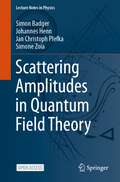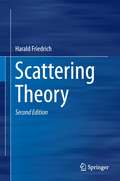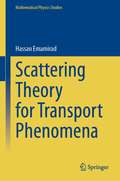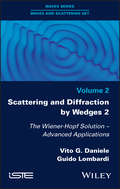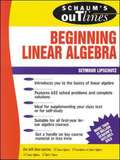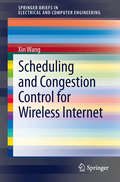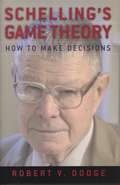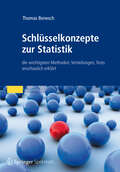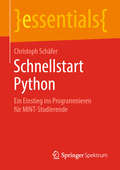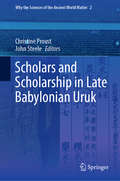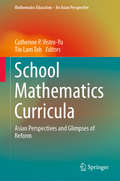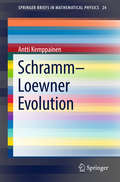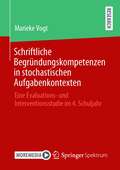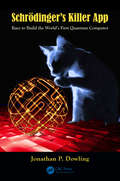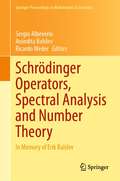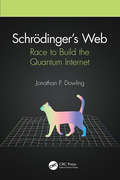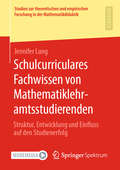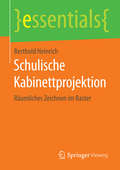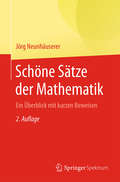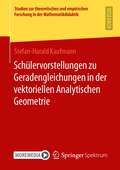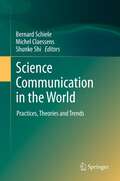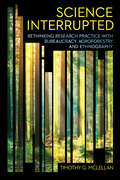- Table View
- List View
Scattering Amplitudes in Quantum Field Theory (Lecture Notes in Physics #1021)
by Simone Zoia Simon Badger Johannes Henn Jan Christoph PlefkaThis open access book bridges a gap between introductory Quantum Field Theory (QFT) courses and state-of-the-art research in scattering amplitudes. It covers the path from basic definitions of QFT to amplitudes, which are relevant for processes in the Standard Model of particle physics. The book begins with a concise yet self-contained introduction to QFT, including perturbative quantum gravity. It then presents modern methods for calculating scattering amplitudes, focusing on tree-level amplitudes, loop-level integrands and loop integration techniques. These methods help to reveal intriguing relations between gauge and gravity amplitudes and are of increasing importance for obtaining high-precision predictions for collider experiments, such as those at the Large Hadron Collider, as well as for foundational mathematical physics studies in QFT, including recent applications to gravitational wave physics.These course-tested lecture notes include numerous exercises with solutions. Requiring only minimal knowledge of QFT, they are well-suited for MSc and PhD students as a preparation for research projects in theoretical particle physics. They can be used as a one-semester graduate level course, or as a self-study guide for researchers interested in fundamental aspects of quantum field theory.
Scattering Theory
by Harald FriedrichThis book presents a concise and modern coverage of scattering theory. It is motivated by the fact that experimental advances have shifted and broadened the scope of applications where concepts from scattering theory are used, e.g. to the field of ultracold atoms and molecules, which has been experiencing enormous growth in recent years, largely triggered by the successful realization of Bose-Einstein condensates of dilute atomic gases in 1995. In the present treatment, special attention is given to the role played by the long-range behaviour of the projectile-target interaction, and a theory is developed, which is well suited to describe near-threshold bound and continuum states in realistic binary systems such as diatomic molecules or molecular ions. The level of abstraction is kept as low as at all possible, and deeper questions related to mathematical foundations of scattering theory are passed by. The book should be understandable for anyone with a basic knowledge of nonrelativistic quantum mechanics. It is intended for advanced students and researchers, and it is hoped that it will be useful for theorists and experimentalists alike.
Scattering Theory for Transport Phenomena (Mathematical Physics Studies)
by Hassan EmamiradThe scattering theory for transport phenomena was initiated by P. Lax and R. Phillips in 1967. Since then, great progress has been made in the field and the work has been ongoing for more than half a century. This book shows part of that progress. The book is divided into 7 chapters, the first of which deals with preliminaries of the theory of semigroups and C*-algebra, different types of semigroups, Schatten–von Neuman classes of operators, and facts about ultraweak operator topology, with examples using wavelet theory.Chapter 2 goes into abstract scattering theory in a general Banach space. The wave and scattering operators and their basic properties are defined. Some abstract methods such as smooth perturbation and the limiting absorption principle are also presented. Chapter 3 is devoted to the transport or linearized Boltzmann equation, and in Chapter 4 the Lax and Phillips formalism is introduced in scattering theory for the transport equation. In their seminal book, Lax and Phillips introduced the incoming and outgoing subspaces, which verify their representation theorem for a dissipative hyperbolic system initially and also matches for the transport problem. By means of these subspaces, the Lax and Phillips semigroup is defined and it is proved that this semigroup is eventually compact, hence hyperbolic. Balanced equations give rise to two transport equations, one of which can satisfy an advection equation and one of which will be nonautonomous. For generating, the Howland semigroup and Howland’s formalism must be used, as shown in Chapter 5. Chapter 6 is the highlight of the book, in which it is explained how the scattering operator for the transport problem by using the albedo operator can lead to recovery of the functionality of computerized tomography in medical science. The final chapter introduces the Wigner function, which connects the Schrödinger equation to statistical physics and the Husimi distribution function. Here, the relationship between the Wigner function and the quantum dynamical semigroup (QDS) can be seen.
Scattering and Diffraction by Wedges 2: The Wiener-Hopf Solution - Advanced Applications
by Vito G. Daniele Guido LombardiThe book has a dual purpose. The first is to expose a general methodology to solve problems of electromagnetism in geometries constituted of angular regions. The second is to bring the solutions of some canonical problems of fundamental importance in modern electromagnetic engineering with the use of the Wiener-Hopf technique. In particular, the general mathematical methodology is very ingenious and original. It is based on sophisticated and attractive procedures exploiting simple and advanced properties of analytical functions. Once the reader has acquired the methodology, she/he can easily obtain the solution of the canonical problems reported in the book. The book can be appealing also to readers who are not directly interested in the detailed mathematical methodology and/ or in electromagnetics. In fact the same methodology can be extended to acoustics and elasticity problems. Moreover, the proposed practical problems with their solutions constitute a list of reference solutions and can be of interests in engineering production in the field of radio propagations, electromagnetic compatibility and radar technologies.
Schaum's Outline of Theory and Problems of Beginning Linear Algebra
by Seymour LipschutzConfusing Textbooks? Missed Lectures? Not Enough Time? Fortunately for you, there's Schaum's Outlines. More than 40 million students have trusted Schaum's to help them succeed in the classroom and on exams. Schaum's is the key to faster learning and higher grades in every subject. Each Outline presents all the essential course information in an easy-to-follow, topic-by-topic format. You also get hundreds of examples, solved problems, and practice exercises to test your skills. This Schaum's Outline gives you practice problems with full explanations that reinforce knowledge, coverage of the most up-to-date developments in your course field, and in-depth review of practices and applications. Fully compatible with your classroom text, Schaum's highlights all the important facts you need to know. Use Schaum's to shorten your study time-and get your best test scores!
Scheduling and Congestion Control for Wireless Internet
by Xin WangThis brief proposes that the keys to internet cross-layer optimization are the development of non-standard implicit primal-dual solvers for underlying optimization problems, and design of jointly optimal network protocols as decomposition of such solvers. Relying on this novel design-space oriented approach, the author develops joint TCP congestion control and wireless-link scheduling schemes for wireless applications over Internet with centralized and distributed (multi-hop) wireless links. Different from the existing solutions, the proposed schemes can be asynchronously implemented without message passing among network nodes; thus they are readily deployed with current infrastructure. Moreover, global convergence/stability of the proposed schemes to optimal equilibrium is established using the Lyapunov method in the network fluid model. Simulation results are provided to evaluate the proposed schemes in practical networks.
Schelling's Game Theory: How to Make Decisions
by Robert V. DodgeThomas Schelling taught a course in game theory and rational choice to advanced students and government officials for 45 years.
Schema Matching and Mapping
by Erhard Rahm Angela Bonifati Zohra BellahseneSchema Matching and Mapping provides an overview of the ways in which the schema and ontology matching and mapping tools have addressed information systems requirements. Topics include effective methods for matching data, mapping transformation verification, mapping-driven schema evolution and merging.
Schlüsselkonzepte zur Statistik
by Thomas BeneschSie suchen ein Buch zur anwendungsorientierten Statistik, in dem Sie das für Sie Wichtige finden, ohne sich durch viele Seiten durcharbeiten zu müssen? Sie haben es gefunden: Das vorliegende Werk erklärt einzelne Konzepte der Statistik übersichtlich auf jeweils drei bis fünf Seiten. Sowohl Konzepte für die Komprimierung und Verdichtung von Datenmaterial (beschreibende Statistik) als auch für die Überprüfung von Vermutungen (Testtheorie) werden behandelt. Alle wichtigen Fragen wie z.B. "Wie gestalte ich eine Untersuchung und wie viele Personen sind dazu nötig?" erklärt Ihnen dieses Buch auf anschauliche Weise. Die verschiedenen statistischen Modelle werden kompakt und übersichtlich präsentiert. Der Autor hat ein besonderes Augenmerk darauf gelegt, die grundlegenden Konzepte mit der Anwendungspraxis zu verbinden. Sie lernen, die einzelnen Modelle nach Ihrer Praxistauglichkeit und Ihren Einsatzmöglichkeiten zu bewerten. Das Werk richtet sich gleichermaßen an Anwender und Studierende, die sich rasch Kenntnisse über Begriffe und Methoden der Statistik aneignen wollen.
Schnellstart Python: Ein Einstieg ins Programmieren für MINT-Studierende (essentials)
by Christoph SchäferChristoph Schäfer stellt die großartige Welt der Programmierung mit Python vor und ermöglicht einen schnellen Einstieg zur eigenständigen Entwicklung von Skripten. Er verweist darauf, wie die Programmiersprache Python sich in den letzten Jahren neben MATLAB und R als Standard an naturwissenschaftlichen Arbeitsplätzen in Forschung und Entwicklung etabliert hat, und zeigt, dass die große Popularität von Python sich in der leichten Erweiterbarkeit begründet: So lassen sich sehr einfach Module von anderen Entwicklern in eigenen Skripten und Programmen verwenden. Der Autor stellt insbesondere die Module NumPy, SciPy und Matplotlib vor, die Naturwissenschaftlern und Ingenieuren eine perfekte Entwicklungsumgebung für Wissenschaftliches und Technisches Rechnen, für Anwendungen in der Physik, Chemie, Biologie und Informatik bieten. Auch in den neuesten Applikationen in den hochaktuellen Gebieten Big Data Science und Machine Learning kommt Python zum Einsatz.Der Autor: Dr. Christoph Schäfer lehrt und forscht in der Abteilung Computational Physics am Institut für Astronomie und Astrophysik an der Eberhard Karls Universität Tübingen.
Scholars and Scholarship in Late Babylonian Uruk (Why the Sciences of the Ancient World Matter #2)
by Christine Proust John SteeleThis volume explores how scholars wrote, preserved, circulated, and read knowledge in ancient Mesopotamia. It offers an exercise in micro-history that provides a case study for attempting to understand the relationship between scholars and scholarship during this time of great innovation. The papers in this collection focus on tablets written in the city of Uruk in southern Babylonia. These archives come from two different scholarly contexts. One is a private residence inhabited during successive phases by two families of priests who were experts in ritual and medicine. The other is the most important temple in Uruk during the late Achemenid and Hellenistic periods. The contributors undertake detailed studies of this material to explore the scholarly practices of individuals, the connection between different scholarly genres, and the exchange of knowledge between scholars in the city and scholars in other parts of Babylonia and the Greek world. In addition, this collection examines the archives in which the texts were found and the scribes who owned or wrote them. It also considers the interconnections between different genres of knowledge and the range of activities of individual scribes. In doing so, it answers questions of interest not only for the study of Babylonian scholarship but also for the study of ancient Mesopotamian textual culture more generally, and for the study of traditions of written knowledge in the ancient world.
School Mathematics Curricula: Asian Perspectives and Glimpses of Reform (Mathematics Education – An Asian Perspective)
by Tin Lam Toh Catherine P. Vistro-YuThis book sheds light on school mathematics curricula in Asian countries, including their design and the recent reforms that have been initiated. By discussing and analyzing various problematic aspects of curriculum development and implementation in a number of East and South Asian countries and offering insights into these countries’ unique approaches to supplementing school mathematics curricula, it contributes to shaping effective policies for implementation, assessment and monitoring of curricula. The book covers a wide range of issues: curriculum design, localization of curricula, directions of curricular reforms, mathematics textbooks, assessment within the curriculum and teachers’ professional development, which are of interest to a wide international audience.
Schramm–Loewner Evolution
by Antti KemppainenThis book is a short, but complete, introduction to the Loewner equation and the SLEs, which are a family of random fractal curves, as well as the relevant background in probability and complex analysis. The connection to statistical physics is also developed in the text in an example case. The book is based on a course (with the same title) lectured by the author. First three chapters are devoted to the background material, but at the same time, give the reader a good understanding on the overview on the subject and on some aspects of conformal invariance. The chapter on the Loewner equation develops in detail the connection of growing hulls and the differential equation satisfied by families of conformal maps. The Schramm-Loewner evolutions are defined and their basic properties are studied in the following chapter, and the regularity properties of random curves as well as scaling limits of discrete random curves are investigated in the final chapter. The book is aimed at graduate students or researchers who want to learn the subject fairly quickly.
Schriftliche Begründungskompetenzen in stochastischen Aufgabenkontexten: Eine Evaluations- und Interventionsstudie im 4. Schuljahr
by Marieke VogtKinder sollen bereits im Mathematikunterricht der Grundschule mathematische Zusammenhänge erklären und begründen. Fraglich ist, wie dieses Thema erfolgreich unterrichtet werden kann. Das vorliegende Buch liefert empirisch überprüfte Ansätze zur Förderung mathematischer Begründungskompetenzen und zeigt auf, wie diese mit dem innermathematischen Themenbereich der Stochastik verknüpft werden können. Die Autorin Marieke Vogt arbeitet derzeit als Grundschullehrerin in Niedersachsen.
Schrodinger's Killer App: Race to Build the World's First Quantum Computer
by Jonathan P. DowlingWritten by a renowned quantum physicist closely involved in the U.S. government's development of quantum information science, this book presents an inside look at the government's quest to build a quantum computer capable of solving complex mathematical problems and hacking the public-key encryption codes used to secure the Internet. The "killer app" refers to Shor's quantum factoring algorithm, which would unveil the encrypted communications of the entire Internet if a quantum computer could be built to run the algorithm. Schrodinger's notion of quantum entanglement-and his infamous cat-is at the heart of it all.
Schrödinger Operators, Spectral Analysis and Number Theory: In Memory of Erik Balslev (Springer Proceedings in Mathematics & Statistics #348)
by Sergio Albeverio Ricardo Weder Anindita BalslevThis book gives its readers a unique opportunity to get acquainted with new aspects of the fruitful interactions between Analysis, Geometry, Quantum Mechanics and Number Theory. The present book contains a number of contributions by specialists in these areas as an homage to the memory of the mathematician Erik Balslev and, at the same time, advancing a fascinating interdisciplinary area still full of potential. Erik Balslev has made original and important contributions to several areas of Mathematics and its applications. He belongs to the founders of complex scaling, one of the most important methods in the mathematical and physical study of eigenvalues and resonances of Schrödinger operators, which has been very essential in advancing the solution of fundamental problems in Quantum Mechanics and related areas. He was also a pioneer in making available and developing spectral methods in the study of important problems in Analytic Number Theory.
Schrödinger’s Web: Race to Build the Quantum Internet
by Jonathan P. DowlingAs the race to build the world&’s first quantum computer is coming to an end, the race to build the quantum internet has just started. This book leverages the author&’s unique insights into both the Chinese and American quantum programs. It begins with the physics and history of the quantum internet and ends with the latest results in quantum computing and quantum networks. The Chinese quantum Sputnik moment. The U.S. National Quantum Initiative. What&’s up with Quantum Computing Supremacy? The Race to Build the Quantum Internet. Where will Quantum Technology be Tomorrow? Written by a renowned quantum physicist, this book is for everyone who is interested in the rapidly advancing field of Quantum Technology — The Second Quantum Revolution. The 2016 launch of the Chinese quantum satellite Mozi was a quantum Sputnik moment. The United States went from thinking it was ten years ahead of the Chinese to the realization that it was ten years behind them. This quantum gap led to the U.S. National Quantum Initiative, launched in 2018. Since then, the race to build the quantum internet has taken off at breakneck speed.
Schubert Calculus and Its Applications in Combinatorics and Representation Theory: Guangzhou, China, November 2017 (Springer Proceedings in Mathematics & Statistics #332)
by Jianxun Hu Changzheng Li Leonardo C. MihalceaThis book gathers research papers and surveys on the latest advances in Schubert Calculus, presented at the International Festival in Schubert Calculus, held in Guangzhou, China on November 6–10, 2017. With roots in enumerative geometry and Hilbert's 15th problem, modern Schubert Calculus studies classical and quantum intersection rings on spaces with symmetries, such as flag manifolds. The presence of symmetries leads to particularly rich structures, and it connects Schubert Calculus to many branches of mathematics, including algebraic geometry, combinatorics, representation theory, and theoretical physics. For instance, the study of the quantum cohomology ring of a Grassmann manifold combines all these areas in an organic way. The book is useful for researchers and graduate students interested in Schubert Calculus, and more generally in the study of flag manifolds in relation to algebraic geometry, combinatorics, representation theory and mathematical physics.
Schulcurriculares Fachwissen von Mathematiklehramtsstudierenden: Struktur, Entwicklung und Einfluss auf den Studienerfolg (Studien zur theoretischen und empirischen Forschung in der Mathematikdidaktik)
by Jennifer LungJennifer Lung entwickelte ein Testinstrument, mithilfe dessen sie das Schulcurriculare Fachwissen von 703 Mathematiklehramtsstudierenden zu unterschiedlichen Zeitpunkten im Studienverlauf erhebt. Diese Trendstudie erlaubt es, die Struktur des Schulcurricularen Fachwissens, dessen Entwicklung im Studienverlauf sowie den Zusammenhang mit dem Studienerfolg zu beschreiben. Die Befunde zeigen, dass sich zwar Teilbereiche des Schulcurricularen Fachwissens im Studienverlauf weiterentwickeln, die Testleistungen jedoch aus Sicht von Hochschullehrenden insgesamt als unzureichend zu bewerten sind. Regressionsanalysen verdeutlichen die Rolle des Schulcurricularen Fachwissens sowohl als Prädiktor als auch als eigenständiger Aspekt von Studienerfolg.
Schulische Kabinettprojektion: Räumliches Zeichnen im Raster (essentials)
by Berthold HeinrichBerthold Heinrich stellt die mathematischen und zeichnerischen Grundlagen für die Darstellung von Objekten im Raum auf kariertem Papier vor. Dabei präsentiert er auch die Nutzung von Software. In der Schule wird oft kariertes Papier als Raster zur Darstellung von Flächen und Körpern genutzt. Allerdings werden, selbst in einigen Druckwerken, z. B. die entstehenden Ellipsen und Winkelbögen ungenau gezeichnet oder eine Kugelkontur falsch als Kreis dargestellt. Im vorliegenden Essential werden die korrekten Verfahren sowohl theoretisch als auch an konkreten Beispielen vorgestellt und können meist direkt umgesetzt werden. Einige aufwändigere Abläufe stellt der Autor anschaulich an Beispielen dar.
Schöne Momente pflegender Angehöriger in der Pflege und Begleitung von Menschen mit Demenz: Eine Tagebuchstudie
by Anna KieferIn diesem Open Access-Buch wird gezeigt, wie pflegende Angehörige mit Hilfe einer Tagebuchvorlage auf die Wahrnehmung schöner Momente in der Begleitung ihrer an Demenz erkrankten Familienmitglieder sensibilisiert werden können. Tagebücher sind eine beliebte Möglichkeit zur Verarbeitung und Bewältigung von Krisensituationen und können dabei der Selbstreflexion und Belastungsverarbeitung dienen. Insbesondere positives Schreiben kann durch das Erinnern und Reflektieren schöner Momente und Emotionen nachweislich zu einem höheren Wohlbefinden und zur Steigerung der Selbstwirksamkeit führen. Die Begleitung eines Menschen mit Demenz geht für pflegende Angehörige häufig mit einer Vielzahl an Belastungen und Herausforderungen einher, weshalb diese häufig aus der Belastungsperspektive erlebt wird. Schöne Momente innerhalb der Sorgebeziehung zwischen pflegenden Angehörigen und Menschen mit Demenz werden dabei seltener bewusst wahrgenommen. Die Ergebnisse der Tagebuchstudie zeigen individuelle Auswirkungen der Wahrnehmung und Sensibilisierung schöner Momente.
Schöne Sätze der Mathematik
by Jörg NeunhäusererIn diesem Buch finden Sie Perlen der Mathematik aus 2500 Jahren, beginnend mit Pythagoras und Euklid über Euler und Gauß bis hin zu Poincaré und Erdös. Sie erhalten einen Überblick über schöne und zentrale mathematische Sätze aus neun unterschiedlichen Gebieten und einen Einblick in große elementare Vermutungen.Die Vielfalt an schönen Resultaten bietet eine einzigartige mathematisch-allgemeinbildende Lektüre auf akademischem Niveau.Die Beweise in diesem Buch sind möglichst einfach und kurz gehalten und vermitteln Ihnen wesentliche Ansätze, Ideen und Strategien ohne große Vorkenntnisse vorauszusetzen. Die verwendeten Begriffe werden zumeist im Text eingeführt und zu grundlegenden Begriffen steht Ihnen zusätzlich ein Anhang zur Verfügung.Als Student der Mathematik oder Naturwissenschaften können Sie das Buch verwenden, um Ihre Perspektive zu erweitern und Ihre mathematische Bildung zu vertiefen. Hochschullehrer können jedes Kapitel des Buches zur Ausgestaltung eines Proseminars heranziehen. Wenn Sie einfach nur an Mathematik interessiert sind, und die Analysis und Lineare Algebra ein wenig kennen, wird Sie dieses Buch in das Reich der reinen Mathematik entführen.Die vorliegende zweite Auflage ist vollständig durchgesehen und um etliche Themen wie zum Beispiel den Satz von Hall und Kettenbrüche ergänzt.
Schülervorstellungen zu Geradengleichungen in der vektoriellen Analytischen Geometrie (Studien zur theoretischen und empirischen Forschung in der Mathematikdidaktik)
by Stefan-Harald KaufmannDie vorliegende qualitative Interviewstudie geht der Frage nach, welche Vorstellungen Schülerinnen und Schüler mit einer Geradengleichung in Vektorform verbinden. Insgesamt 22 Schülerinnen und Schüler der gymnasialen Oberstufe werden mit Hilfe eines leitfadengestützten, problemzentrierten Interviews zu Geradengleichungen in Vektorform aus unterschiedlichen Perspektiven befragt. Die Auswertung der Interviews erfolgt mit einer an die Grounded Theory angelehnten Kategoriengenerierung und einer typenbildenden qualitativen Inhaltsanalyse, die die Bildung von 6 verschiedenen Typen ermöglicht.
Science Communication in the World
by Michel Claessens Shunke Shi Bernard SchieleThis volume is aimed at all those who wonder about the mechanisms and effects of the disclosure of knowledge. Whether they have a professional interest in understanding these processes generally, or they wish to conduct targeted investigations in the PCST field, it will be useful to anyone involved in science communication, including researchers, academics, students, journalists, science museum staff, scientists high public profiles, and information officers in scientific institutions.
Science Interrupted: Rethinking Research Practice with Bureaucracy, Agroforestry, and Ethnography (Expertise: Cultures and Technologies of Knowledge)
by Timothy G. McLellanScience Interrupted examines how scientists in China pursue environmental sustainability within the constraints of domestic and international bureaucracies. Timothy G. McLellan offers a theoretical framework for analyzing the formal procedural work of Chinese bureaucracy—work that is overlooked when China scholars restrict their gaze to the informal and interpersonal channels through which bureaucracy is often navigated. Homing in on an agroforestry research organization in southwest China, the author takes the experiences of the organization's staff in navigating diverse international funding regimes and authoritarian state institutions as entry points for understanding the pervasiveness of bureaucracy in contemporary science. He asks: What if we take the tools, sensibilities, and practices of bureaucracies seriously not only as objects of critique but as resources for re-thinking scientific practice? Extending a mode of anthropological research in which ethnography serves as source of theory as well as source of data, Science Interrupted thinks with, and not only against, bureaucracy. McLellan shows that ethnographic engagement with bureaucracy enables us to imagine more democratic and more collaborative modes of scientific practice.
